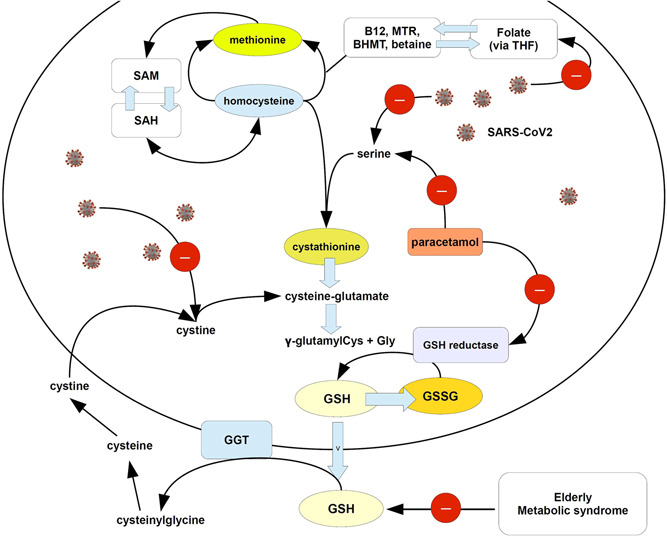Figure 1.

Cartoon showing the possible mechanism of exacerbation of GSH depletion in subjects infected with SARS‐CoV‐2 by paracetamol. As explained in the text, SARS‐CoV‐2 negatively affects the serine pathway leading to cystathionine synthesis and the uptake of folate, dysregulating the one‐carbon metabolism. Folate can be reduced to tetrahydrofolate (THF) and then converted to 5‐methyl THF, whereas a reaction catalyzed by methionine synthetase, transfers the methyl group of 5‐methyl‐THF to homocysteine, generating methionine. SARS‐COV‐2 impairs also other thiolic‐exchanging pathways, such as Cys. On the other hand, paracetamol can inhibit the serine pathway and the sulfur amino acid pathway (see Mast C, Dardevet D, Papet I. Impact of medication on protein and amino acid metabolism in the elderly: the sulfur amino acid and paracetamol case. Nutr Res Rev. 2018 Dec;31(2):179‐192.) and also GSH reductase (see Rousar T, Pařík P, Kucera O, Bartos M, Červinková Z. Glutathione reductase is inhibited by acetaminophen‐glutathione conjugate in vitro. Physiol Res. 2010;59(2):225‐232.). Arrows with red circle and minus sign = inhibition. BHMT, betaine homocysteine methyltransferase; GSH, glutathione; GSSG, oxidized GSH; SAH, S‐adenosyl homocysteine; SAM, S‐adenosylmethionine; SARS‐CoV‐2, severe acute respiratory syndrome coronavirus 2
